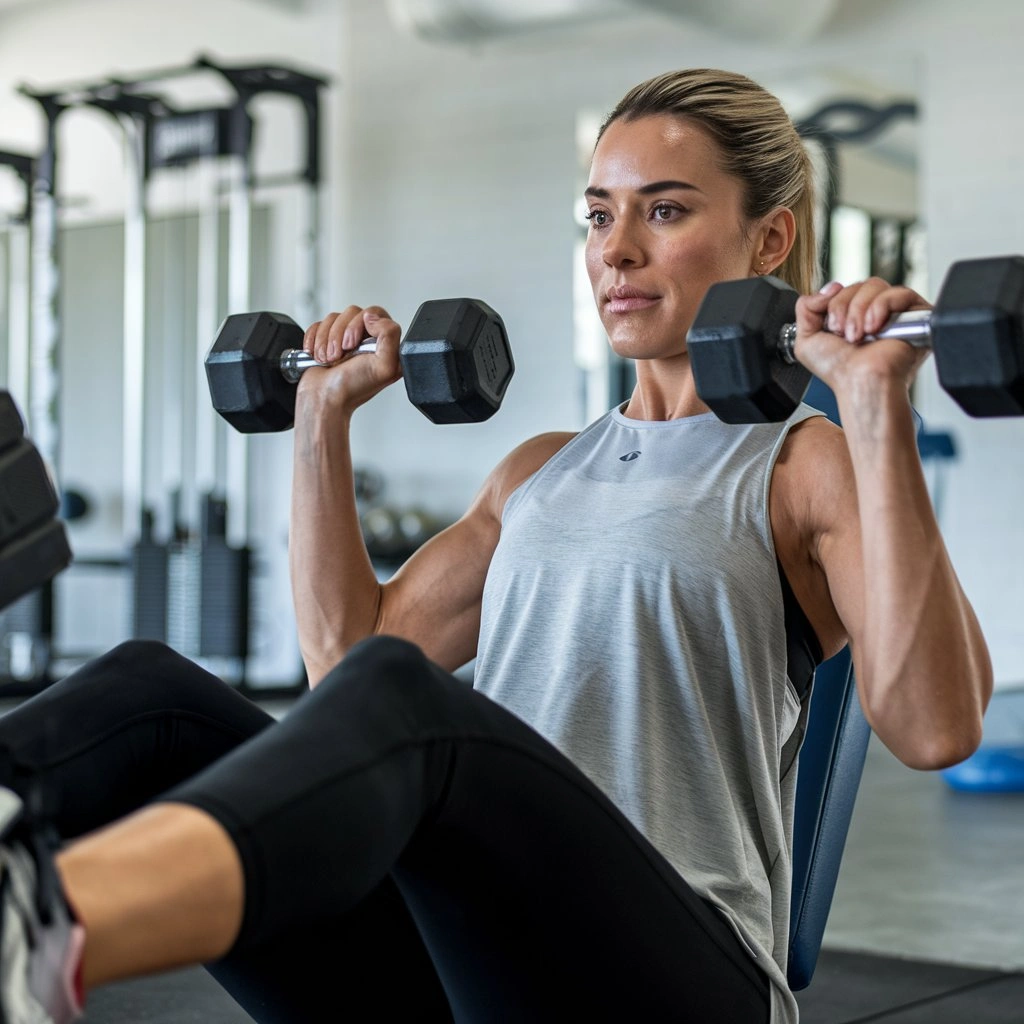The Leg Press Machine: A Gym Staple
Leg press machine alternatives are common in any well-equipped gym. It provides a seated position. You push a weighted platform with your legs. This targets the quadriceps, the muscles in the front of your thighs. This machine offers a controlled and isolated way to train your lower body.
It is popular among both beginners and seasoned gym-goers. There are Variations of the Leg Press. For example, the 45-degree leg press emphasizes different leg muscles. This depends on foot placement.
The Power of Strong Legs: A Foundation for Fitness
Leg exercises are a crucial component of any well-rounded strength training program. Strong legs provide the base for powerful movements, like squats, jumps, and lunges. They also help with both sports and daily life.
Developed leg muscles improve balance, stability, and posture, all essential for injury prevention. Additionally, strong legs can boost metabolism and contribute to better body composition.
Beyond the Machine: Embracing Alternatives
The leg press is effective. But, sometimes we need alternatives. You may have limited gym access, lack space at home, or prefer it. All these can call for a different approach to leg training. Bodyweight exercises are great.
They need no equipment and can done anywhere, anytime. Squats, lunges, and variations offer fantastic leg workouts without a machine. Resistance bands can be added to leg exercises for those with access to some equipment. They add extra challenges and target different muscles.
 Bodyweight Exercises
Bodyweight Exercises
When it comes to leg training, fancy Gym Equipment isn’t always necessary. Bodyweight exercises offer a great way to build strong, toned legs. They also improve athletic performance and boost fitness. Plus, you can do them at home without a gym membership. This guide explores effective lower-body bodyweight exercises. It focuses on variations. They target different muscles and challenge you at various fitness levels.
Bodyweight Squat Variations
The squat is a king among leg exercises, and for good reason. It works many muscles in your lower body. These include the quads, hamstrings, glutes, and calves. Here are three variations to add variety and challenge to your squat routine:
- Traditional Bodyweight Squat: This is the foundation. Stand with your feet shoulder-width apart, toes pointed outwards. Keep your back straight and core engaged as you lower yourself down as if sitting in a chair. Descend until your thighs are parallel to the ground, then press back up to the starting position. Focus on keeping your knees tracking over your toes throughout the movement.
- The Pistol Squat is an advanced variation. It requires balance and coordination at a new level. Stand on one leg, raising the other straight out in front of you. Slowly lower yourself down until your sitting thigh is parallel to the ground. Push back up to the starting position with control. It’s okay to hold onto a chair or wall for support if needed as you build strength.
- Jump Squats are explosive. They add a plyometric element to the squat. This increases power and builds Stronger Leg Muscles. Perform a traditional squat, then at the bottom of the movement, explode upwards into a jump. Land and immediately lower into another squat for continuous repetitions.
Lunges and Variations
Lunges are another excellent exercise for targeting your quads, hamstrings, and glutes. They also improve balance and stability. Here are three lunge variations to keep your lower body workout dynamic:
- Forward Lunges: Stand with your feet hip-width apart. Take a large step forward with one leg, lowering your body until both knees are bent at 90-degree angles. Ensure your front knee tracks over your ankle and your back knee doesn’t touch the ground. Push back up to the starting position and repeat with the other leg.
- Reverse Lunges: Similar to forward lunges, but you step backward instead of forward. This variation emphasizes your hamstrings more than the quads. Maintain a tall posture and keep your core engaged throughout the movement.
- Walking Lunges are dynamic. They keep your heart rate up and add coordination. Take a large step forward with one leg, lowering your body into a lunge. Push off with your front foot and bring your back leg forward to meet it, performing a lunge on the other side. Continue this walking motion, alternating legs with each step.
 Step-ups
Step-ups
Step-ups are simple. Yet, they are highly effective exercises. They strengthen your quads, glutes, and calves. Find a sturdy bench, chair, or step that is challenging but allows you to maintain proper form. Step up onto the platform with one leg, bringing your other knee up towards your chest as you rise. Step back down with the same leg and repeat with the other leg.
Bulgarian Split Squats
This single-leg exercise is a great way to challenge your balance. It builds strength in both legs separately. Stand in front of a bench or sturdy chair with one leg resting behind you on the platform. Keep your back straight and core engaged. Lower yourself until your front knee is bent at a 90-degree angle. Push back up to the starting position and repeat with the other leg.
These are a few of the many good bodyweight exercises. You can add them to your lower body workout. Remember to start with proper form. Then, increase the difficulty or repetitions as you get stronger. With dedication and consistency, you can build strong, sculpted legs. You can do it using nothing but your body weight.
Resistance Band Exercises
Bodyweight exercises are a great foundation for strong legs. But, those seeking an extra challenge or targeting specific muscles. Resistance bands offer a handy solution. These elastic bands come in various resistance levels.
You can add them to many traditional leg exercises to make them harder and push your muscles further. Let’s explore some effective resistance band exercises to elevate your lower body workouts:
Resistance Band Squats
Take your regular squats to the next level with resistance bands. Here are two variations to target different muscle groups:
- Squats with Band Above the Knees: Loop a resistance band above your knees. Perform a traditional squat, focusing on keeping the band taut throughout the movement. This variation adds extra resistance to your quads on the way up and glutes on the way down.
- Squats with Band Below the Knees: Loop the band around your ankles. As you squat down, the band will try to pull your knees inward. Fight this by pushing your knees outwards against the resistance. This version targets your inner thighs (adductors) and helps improve stability.
Resistance Band Lunges
Lunges are great for building leg strength. Adding resistance bands can raise the challenge. Here are two ways to incorporate resistance bands:
- Lunges with Band Around Ankles: Loop the band around both ankles, above your shoes. Perform forward lunges as usual. The band will provide resistance as you push off with your back leg and return to the starting position. This variation hits both your quads and hamstrings.
- Side Lunges with Banded Loop: Put the loop around your ankles. Then, stand with your feet hip-width apart. Step out to the side with one leg, keeping your back straight and core engaged. Lower your body until your hips are bent, then push back up to the starting position. Repeat with the other leg. This variation targets your outer thighs (abductors) and improves hip stability.
Resistance Band Leg Press Simulation
You won’t copy the leg press’s movement with bands. But, bands can give a similar leg workout. They keep the ease of a bodyweight exercise. Here’s how:
- Sit on the floor with your legs extended in front of you. Loop a resistance band around your feet. Push your heels against the band, simulating the pushing motion of a leg press. Focus on squeezing your glutes and hamstrings at the top of the movement.
- For an added challenge, elevate your lower back by placing it on a bench or exercise ball. This variation increases the motion range. It also activates your glutes and hamstrings more.
Resistance Band Step-ups
Step-ups are great for building quads and glutes. Resistance bands can make them harder. Here’s how to incorporate them:
- Hold a resistance band under your feet with both hands. Step up onto a sturdy bench or platform as you would in a regular step-up. As you push through your heel to rise, pull the band upwards against your body. This adds resistance throughout the movement, targeting both your quads and glutes.
- For an advanced variation, loop the band around your upper back and hold the ends in your hands. Perform the step-up as described above. This variation adds core engagement and challenges your stability.
 Dumbbell Exercises
Dumbbell Exercises
Dumbbells are a great way to add weight and intensity to leg workouts. They take your lower body training to the next level. Dumbbells are better than bodyweight exercises. They allow for progressive overload. T
his means you can increase your weight. That will keep challenging your muscles and spur muscle growth. Here are some effective dumbbell exercises to target your quads, hamstrings, and glutes:
Dumbbell Goblet Squat
This squat variation offers a core challenge while strengthening your quads and glutes. Hold a single dumbbell in front of your chest, cupping the bottom end with both hands. Stand with your feet shoulder-width apart.
Squat down as if sitting in a chair. Keep your back straight and your core engaged. Descend until your thighs are parallel to the ground, then push back up to the starting position.
Dumbbell Lunges
Lunges are a staple leg exercise, and dumbbells add an extra layer of difficulty. Here are two variations to target different muscle groups:
- Forward Dumbbell Lunges: Hold a dumbbell in each hand at your sides. Take a large step forward with one leg, lowering your body until both knees are bent at 90-degree angles. Ensure your front knee tracks over your ankle and your back knee doesn’t touch the ground. Push back up to the starting position and repeat with the other leg.
- Reverse Dumbbell Lunges are similar to forward lunges. But, you step backward instead of forward. This variation emphasizes your hamstrings more than the quads. Maintain a tall posture and keep your core engaged throughout the movement.
Dumbbell Step-ups
Step-ups become even more challenging with dumbbells in hand. Find a sturdy bench or platform that is challenging but allows you to maintain proper form. Hold a dumbbell in each hand at your sides.
Step up onto the platform with one leg, bringing the other knee up towards your chest as you rise. Lower yourself back down with the same leg and repeat with the other leg.
Dumbbell Bulgarian Split Squats
This exercise is a powerhouse for building single-leg strength and stability. Stand in front of a bench or sturdy chair. Put one leg behind you on the platform. Hold a dumbbell in each hand at your sides. Keep your back straight and core engaged.
Lower yourself until your front knee is bent at a 90-degree angle. Push back up to the starting position and repeat with the other leg. These are a few of the many dumbbell exercises. You can add them to your leg workout.
Remember to choose a weight that lets you keep proper form. Do this for all the repetitions. Start with lighter weights and increase as you get stronger. By doing these exercises, you’ll be on your way to building strong, sculpted legs. You’ll also improve your fitness.
Kettlebell Exercises
Kettlebells have a unique off-center weight. They offer a dynamic way to train your legs. They add instability to exercises. It challenges your core and improves coordination. They also strengthen your lower body. Here are some effective kettlebell exercises to target your quads, hamstrings, and glutes:
Kettlebell Goblet Squat
This squat variation provides a core challenge alongside strengthening your quads and glutes. Hold a kettlebell by the horns (the handle end). Hold it in front of your chest. Keep your elbows tucked in. Stand with your feet shoulder-width apart.
Squat down as if sitting in a chair. Keep your back straight and core engaged. Descend until your thighs are parallel to the ground, then push back up to the starting position. The kettlebell’s weight distribution will engage your core to stabilize the movement.
Kettlebell Lunges
Lunges are a classic leg exercise, and kettlebells add an exciting twist. Here are two variations to target different muscle groups:
- Kettlebell Forward Lunges: Hold a kettlebell in each hand by the horns, at your sides. Take a large step forward with one leg, lowering your body until both knees are bent at 90-degree angles. Ensure your front knee tracks over your ankle and your back knee doesn’t touch the ground. The kettlebell’s off-center weight challenges your core. It makes it maintains balance during the movement. Push back up to the starting position and repeat with the other leg.
- Kettlebell Reverse Lunges are like forward lunges. But, you step backward instead of forward. This variation emphasizes your hamstrings more than the quads. Keep a tall posture. Engage your core to make up for the kettlebell’s weight distribution.
Kettlebell Step-ups
Step-ups become even more dynamic with a kettlebell in hand. Find a sturdy bench or platform that is challenging but allows you to maintain proper form. Hold a kettlebell by the horn in one hand at your side.
Step up onto the platform with the same leg that’s holding the kettlebell. Bring the other knee up towards your chest as you rise. Lower yourself down with the same leg. Then, repeat with the other leg. Switch hands with the kettlebell each time.
Kettlebell Bulgarian Split Squats
This exercise takes single-leg strength and stability to another level. Stand in front of a bench or sturdy chair with one leg resting behind you on the platform. Hold a kettlebell by the horn in one hand at your side (opposite the resting leg).
Keep your back straight and core engaged. Lower yourself until your front knee is bent at a 90-degree angle. The kettlebell’s weight challenges your core to stabilize you as you descend. Push back up to the start and repeat with the other leg. Switch hands with the kettlebell each time.
 Stability Ball Exercises
Stability Ball Exercises
Stability balls, also called Swiss balls, offer a unique training tool. It goes beyond core exercises. You can add them to your leg workout. They add instability that challenges your core and improves balance. They also strengthen your lower body. Here are some good stability ball exercises. They target your quads, hamstrings, and glutes.
Stability Ball Squats
This variation on the classic squat adds a core challenge to your leg workout. Sit on a stability ball with your feet shoulder-width apart, flat on the floor. Walk your feet out slightly further than you would for a regular squat. Engage your core and slowly walk your hands back, lowering your body down as if sitting in a chair.
Maintain a straight back and keep your gaze forward. Descend until your thighs are parallel to the ground, or as low as you can comfortably go while maintaining good form. Push back up to the starting position by pressing through your heels and engaging your glutes.
Stability Ball Leg Curls
This exercise isolates your hamstrings while challenging your balance. Lie face-up on the floor with your heels resting on top of the stability ball. Keep your arms at your sides or place them under your lower back for added support. Press your hips upwards to form a bridge position with your body in a straight line from shoulders to knees.
Keeping your core engaged and back straight, slowly roll the ball towards your glutes by flexing your knees. Curl your heels in towards you, squeezing your hamstrings at the peak of the contraction. Slowly roll the ball back to the starting position and repeat.
Stability Ball Wall Squats
This variation provides additional support for your back while still engaging your core and challenging your legs. Stand with your back flat against a wall, a stability ball positioned between your lower back and the wall.
Slide down the wall until your knees are bent at 90-degree angles, keeping your feet flat on the floor and shoulder-width apart. The ball will help you maintain a proper squat depth. Hold this position for a count, then press through your heels to return to the starting position.
Conclusion
The leg press machine is a valuable tool for leg training, but it’s not the only option. This guide has explored a variety of alternative exercises that can be just as effective, if not more so, in building strong, toned legs. We’ve covered bodyweight exercises like squats, lunges, and step-ups, all requiring no equipment and are perfect for home workouts.
Resistance bands offer a convenient way to add intensity to these exercises, while dumbbells and kettlebells provide opportunities for progressive overload, allowing you to continually challenge your muscles for growth. Stability ball exercises add an element of instability, further engaging your core and improving balance alongside strengthening your legs.
Why Variety Matters
Incorporating a variety of exercises into your leg workout routine is crucial for maximizing results and preventing plateaus. Different exercises target different muscle groups and work your legs in slightly different ways.
By incorporating a mix of bodyweight exercises, weighted exercises, and stability ball exercises, you ensure the well-rounded development of your leg muscles. Variety also helps keep your workouts interesting and prevents boredom, which can derail your fitness goals.
Finding Your Perfect Fit
The beauty of having so many alternative exercises lies in the ability to find what works best for you. Consider your fitness goals, equipment availability, and personal preferences. If you’re new to exercise, bodyweight exercises are a fantastic starting point. As you progress, you can incorporate resistance bands, dumbbells, or kettlebells.
Stability ball exercises offer a unique challenge and can be a great addition to any workout routine. Ultimately, the key to building strong legs lies in consistency and proper form. Experiment with different exercises, find what works for you, and challenge yourself progressively.
With dedication and the plethora of exercises explored in this guide, you can achieve toned, powerful legs, regardless of whether you have access to a leg press machine or not. So lace up your shoes, grab your preferred equipment (or no equipment at all!), and embark on your journey to building strong, healthy legs!

